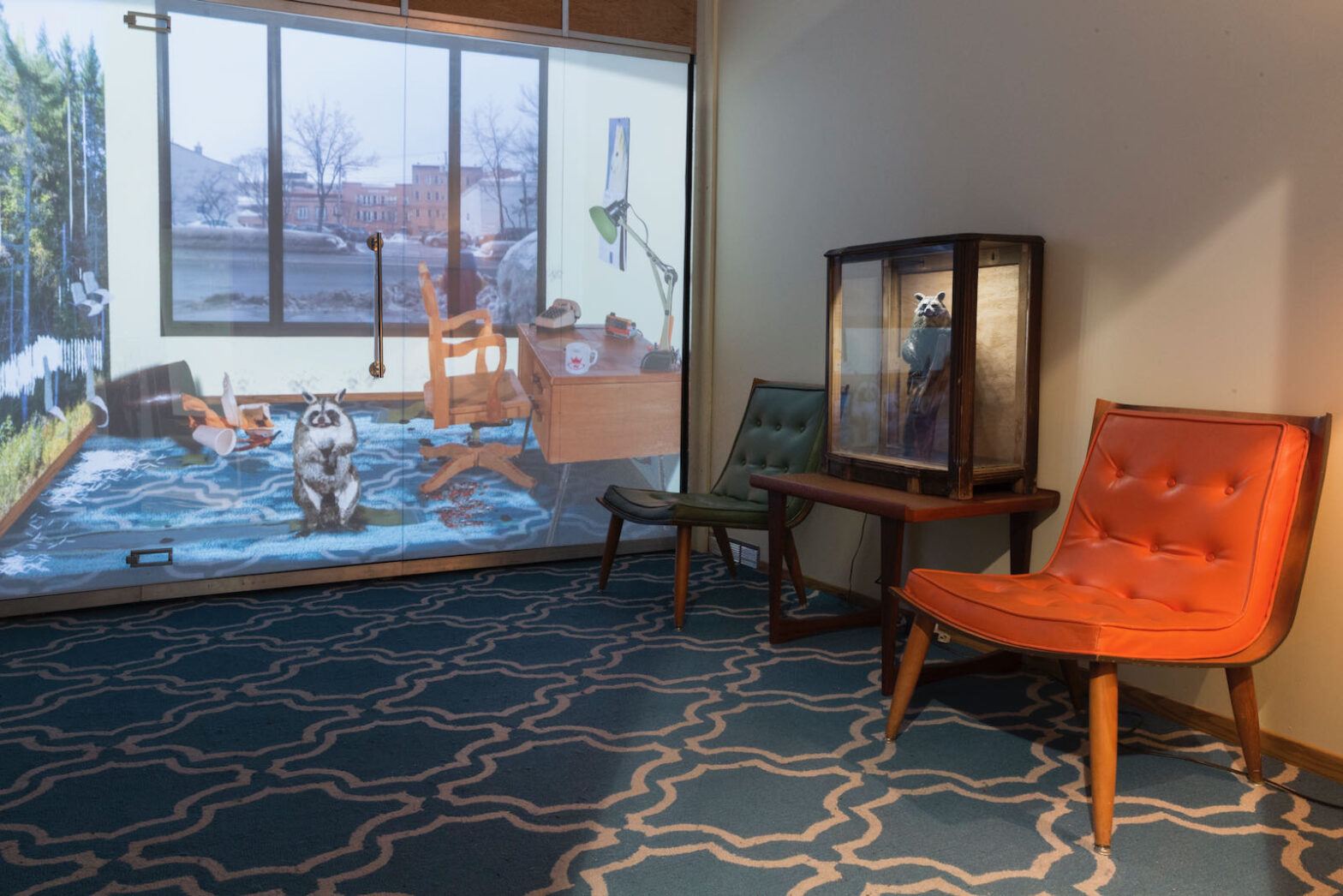For the Mois Multi 2018’s program, Graeme Patterson adapted an installation originally designed for the BMO Project Room, a small office on the 68th floor of the Bank of Montreal’s Toronto headquarters, which annually hosts an artist project that can be visited by appointment.
At the Galerie des arts visuels de l’Université Laval, Patterson built an autonomous structure reproducing the BMO project room and it’s contained installation. The reconstruction occupies only part of the gallery. The space thus delimited appears from the outside as a sculptural element vaguely evoking the minimalist formal sculpture. The rhythm of its structure and proportions make it look like a container. This reference to the transport of goods underscores the displacement of the project. It also indirectly underlines the status both cities share as St. Lawrence Seaway ports: Quebec being the last deep water port on the St. Lawrence, and Toronto, the largest inland port in Canada.
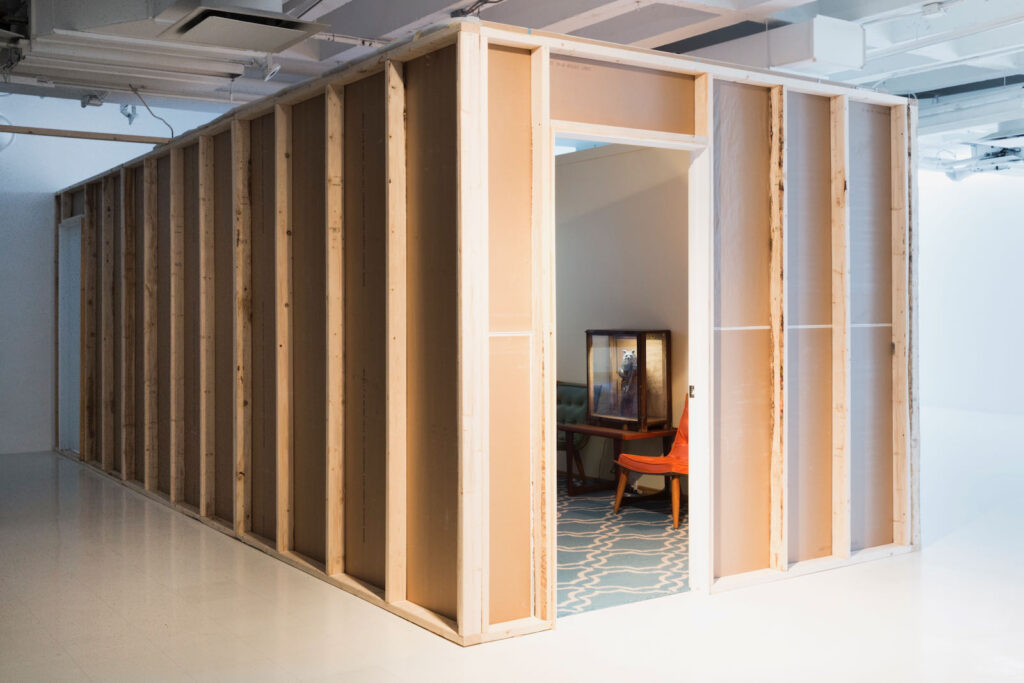
Within the structure, a glass wall serving as a rear-projection screen shows a frame-by-frame animation of a raccoon living in a 1950’s era office. Apparently conscious of our presence the racoon reacts unpredictably to our movements, turning towards us, grunting and tapping on the glass as if to implore us to release it, then ignoring us and returning to its activities, confined to an environment foreign to its wild nature. Sometimes visibly irritated by this situation, he spills the trash, spreads the accumulated rubbish, tears the wallpaper or carpet and shrieks aggressively. At other times he opens the drawer to feed on a chocolate bar, turns off the office light, or stops, looks at us and tries to communicate with us.
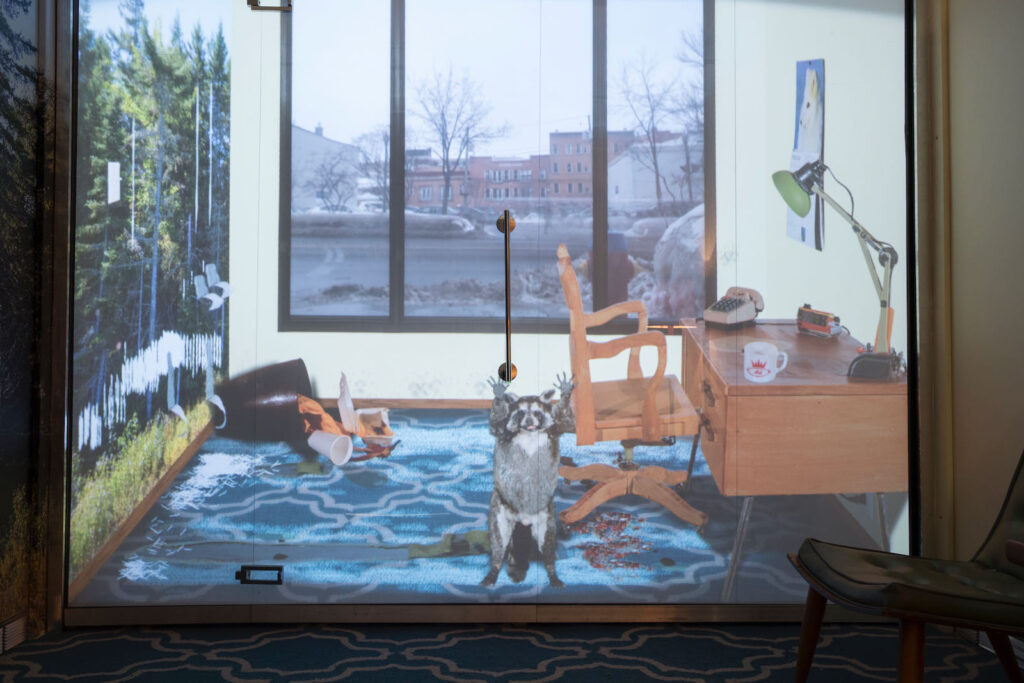
In the structure’s waiting room where we are confined as visitors, two armchairs are placed on either side of a showcase presenting a raccoon in a still position evoking its natural behaviour. This racoon figurine is the puppet seen in the animation. Facing the raccoon, wallpaper matching the animation’s office décor, depicts the boreal forest, the largest vegetation area in Canada. The boreal forest is both the habitat favoured by the raccoon and the territory that surrounds Graeme Patterson daily in Sackville, New Brunswick, his chosen home. Reminiscent of wall murals once in fashion as interior decoration, this wallpaper and the furnishings visually connect the waiting and office space. The installation also incorporates, a real-time video capture of the activity taking place on the street in front of the Visual Arts Gallery, the point of view on the outside appearing technically in installation.
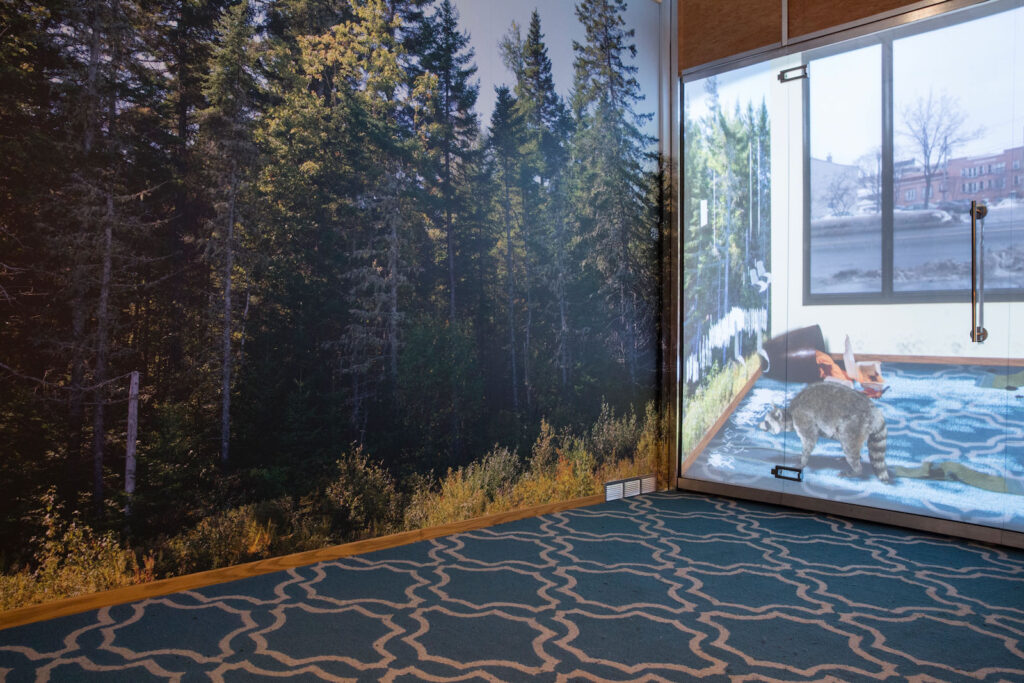
Dioramas Nesting
Patterson’s staging within the gallery space owes much to dioramas of natural science museums, designed to imbue the viewer with the reality of ecosystems by matching two-dimensional planes and three-dimensional space, truth and fiction, geographical distance and promiscuity.
In a special issue of the Montreal based art magazine Espace Art Actuel, the editor Mélanie Boucher emphasizes that the museum presentation of dioramas portends intermediality, a fertile ground for digital cultures today. She also reports that Ralph Rugoff, director of the Hayward Gallery in London (UK) and curator of the 2019 Venice Biennale, considers (in Small World: Dioramas in Contemporary Art) the illusionist and spectacular effects sought by these staging as introductory forms of virtual reality. This kinship now favours the resurgence of these exhibition formats dating back to the end of the 19th century. Without apparent disruption, Graeme Patterson thus integrates frame-by-frame animation into his installation, using video game design software.
While unclear and broad, the term “diorama” refers to presentation methods aimed at creating an unusual optical experience through an illusion. Taken as a whole, Graeme Patterson’s A Suitable Den gives us a glimpse of these manifestations: the office where the raccoon moves, the figurine still in a natural gesture within the vitrine, the layout of the waiting room and the street scene unfolding in real time challenge us in a similar way, subordinated to spectacular immersion and verisimilitude.

The unpredictability of the animation, however, gives life to the raccoon. The use of technology serves the purpose of imitating nature, similar to those that animated manufacturers of automata anxious to reproduce the movement characteristic of the human or animal figures they represented. One feels here the same astonishment and the same amusement as at the sight of an automaton. On the other hand, while one quickly identifies the ins and outs of the prodigious mechanics of the time, the contribution of technology, in particular the programming resulting from an infinite random combination of successive actions, confounds even more the relations of the living and technique. The gallery staff and the artist himself were sometimes surprised by some of the raccoon gestures. In this interstice, the animal and the technology present themselves with an autonomous power to act, today in constant dialogue with our imagination, and also subject to our actions.
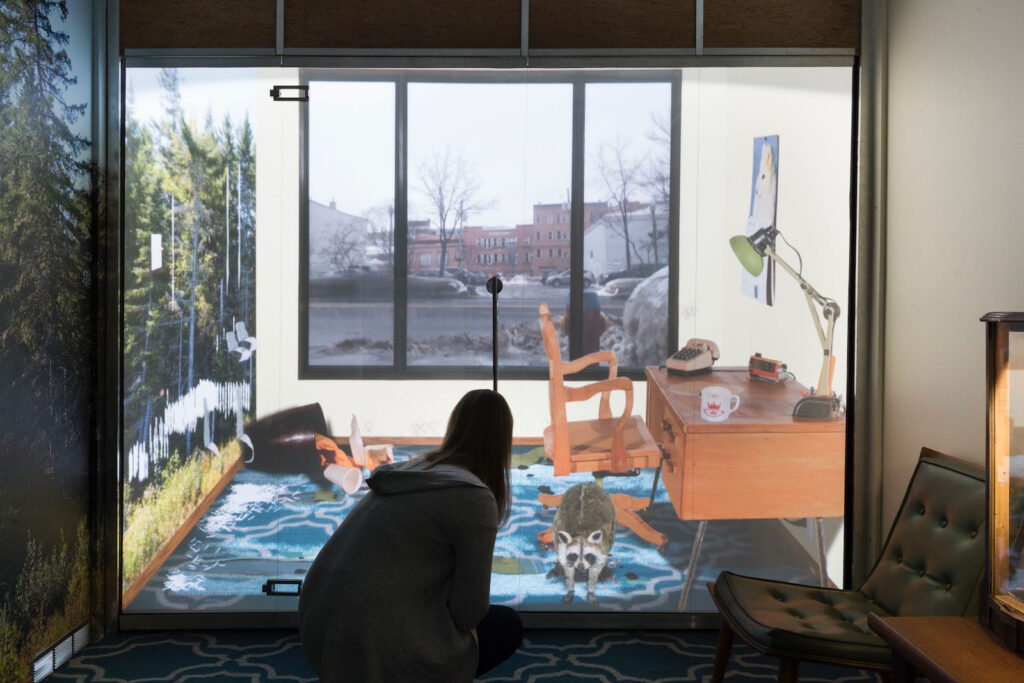
Thus, another scene takes place in the waiting room where one enters to apprehend the work and interact with it. The teasing visitor by moving a virtual raccoon to anger, for the simple pleasure of seeing him react, is indeed an important actor of the scene. A part of the artist’s project is elaborated on our side of the wall. The device thus turns on itself and highlights the scopic drive that motivates us to push the door of the gallery. The various visual components embedded in this staged complex, the carpet and the wallpaper, the showcase and the design of the old-fashioned furniture, as well as the multimedia projection and the real-time point of view on the outside, all underline the multiple forms the visible borrows today to challenge us. Its manifestations are constantly multiplying in favor of an ecosystem where the proliferation of images is a living condition of our societies, here exposed before our eyes.
Beyond zoomorphism
The use of animalisation is a recurring feature of Graeme Patterson’s work. As his participation in the 2008 Symposium international d’art contemporain de Baie-Saint-Paul, he produced a series of photographs featuring puppet animals, each being an effigy of a participating artists.
In the Woodrow (2007), using emblematic locations of the family farm in a small community in Saskatchewan, he nostalgically portrays rural life and daily interactions with domestic, synanthropic or wild animals. The storytelling in the resulting videos favour the expression of a narrative encouraging an identification with the animal, confusing the gaze that one places onto it with the expression of its particular condition and concerns. In Secret Citadel (2013), a bison and cougar made entirely by hand are staged in a decor furnished with accessories to their size. They replay the events of childhood, adolescence and early adulthood of the artist, marked by male complicity, a phantasmagoria transforming into myth previous experiences of loss, abandonment and alienation. The animality of the characters remains here somewhat accessory.
With Starling Cage, presented at Galerie 3 in Québec City in 2015, Graeme Patterson begins a body of works where he develops another perspective on the animals. This interactive work involves a starling, a species native to Eurasia, now naturalized in Canada and possibly introduced to Central Park (NYC) by Eugene Schieffelin as a Shakesperian fantasy, or to act in the biological fight against pests as well as a pet appreciated for its singing and mocking abilities. The starling’s often very dense populations sometimes give it the status of invasive species subject to control measures. As such, the work Starling Cage offers us to replay, in a fun way, gestures related to the subjection of animals to human will.
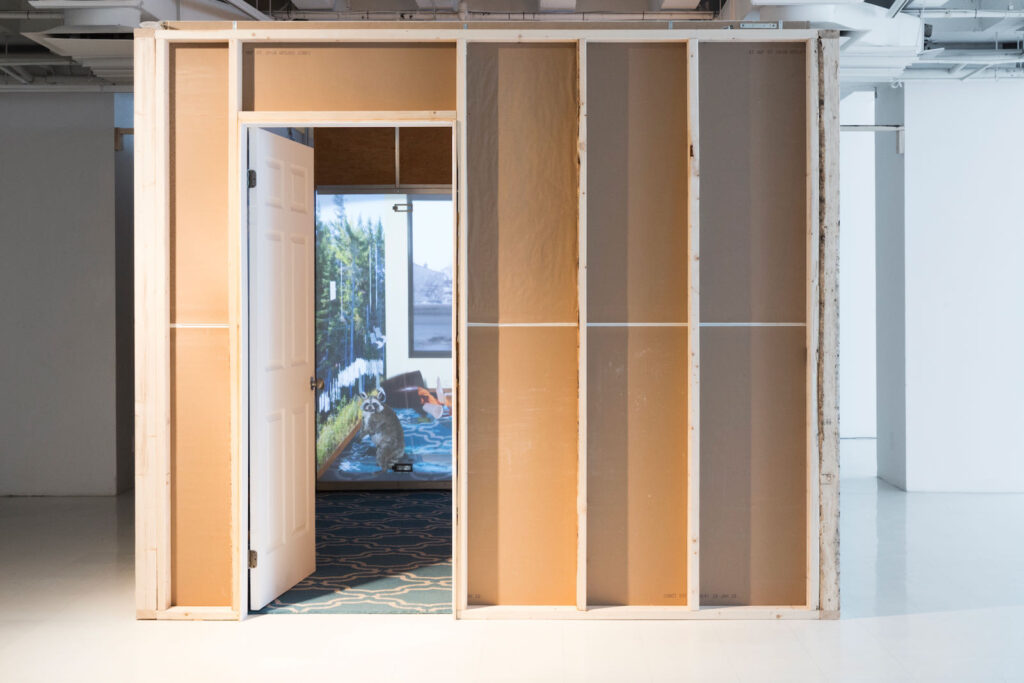
A Suitable Den uses the raccoon character in the same way. The work is inspired by the escalating number of incidents related to the interaction of humans with animals perceived as wild, but who do not hesitate to share the territory of man and claiming it as their owns in response to the progressive disappearance of the natural environment. Through the interactions he offers to visitors, Graeme Patterson invites us to experience this asymmetrical visibility that reduces nature to a picturesque spectacle and engages a mutually exclusive cohabitation of humans and animals.
He also sprinkles many references to the Cartesian conception of human superiority over nature. In the initial presentation of the project in Toronto, the integration of real-time video captured the panorama of downtown from the perspective of an office in a skyscraper to embody this perception of reality subordinated to a dominant point of view. In contrast to the majestic nature of Lake Ontario, hinted at in the background, the importance of the built and concrete environment and city smog reflect the negative effects on the natural characteristics of this land grab. Similarly, the reference to behaviors of synanthropic species, such as the starling and raccoon, reflects the limits of the definition of mutually exclusive territories of humans and the rest of the living world. In Quebec City, the viewpoint from l’Université Laval on Charest Boulevard subjects these apparently seemingly arrangements to our territorial occupation to a similar review and challenges our utilitarian or scenic focus on the environment.
In keeping with his personal choice to settle in a New Brunswick rural community, Graeme Patterson sees the need to rethink our relationship to the living as a network of interactions between species. Beyond the playful design that it proposes, A Suitable Den challenges us to question our ways of inhabiting the territory we share with animals.
(Translated from French by the author with the collaboration of Katherine Knight and Anne Ramsden)

